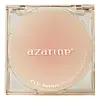Azarine It’s So Porefect! Powder Foundation Versus Y.O.U Cloud Touch Dreamy-Fit Lasting Mesh Cushion
What's inside
What's inside
 Key Ingredients
Key Ingredients

 Benefits
Benefits

 Concerns
Concerns

 Ingredients Side-by-side
Ingredients Side-by-side

Talc
AbrasiveMica
Cosmetic ColorantSilica
AbrasiveCaprylic/Capric Triglyceride
MaskingNylon-12
Magnesium Myristate
Phenyl Trimethicone
Skin ConditioningKaolin
AbrasiveEctoin
Skin ConditioningEthylhexyl Methoxycinnamate
UV AbsorberTocopherol
AntioxidantAscorbic Acid
AntioxidantSqualane
EmollientCeramide EOP
Skin ConditioningDiisostearyl Malate
EmollientPhenoxyethanol
PreservativeWater
Skin ConditioningIsododecane
EmollientCyclopentasiloxane
EmollientGlycerin
HumectantPropylene Glycol
HumectantCyclohexasiloxane
EmollientCetyl PEG/PPG-10/1 Dimethicone
EmulsifyingEthylhexyl Methoxycinnamate
UV AbsorberDimethicone
EmollientSodium Chloride
MaskingTrimethylsiloxysilicate
EmollientPhenoxyethanol
PreservativeMagnesium Stearate
Cosmetic ColorantBoron Nitride
AbsorbentDisteardimonium Hectorite
StabilisingHydrogenated Polyisobutene
EmollientMica
Cosmetic ColorantCamellia Sinensis Leaf Extract
AntimicrobialButylene Glycol
HumectantLactobacillus/Soybean Ferment Extract
Skin ConditioningViscum Album Leaf Extract
SoothingImperata Cylindrica Root Extract
Skin ConditioningCeramide EOP
Skin ConditioningCentella Asiatica Leaf Extract
Skin ConditioningHoney Extract
HumectantEthylhexylglycerin
Skin ConditioningParfum
MaskingCI 77891
Cosmetic ColorantCI 77491
Cosmetic ColorantCI 77492
Cosmetic ColorantCI 77499
Cosmetic ColorantWater, Isododecane, Cyclopentasiloxane, Glycerin, Propylene Glycol, Cyclohexasiloxane, Cetyl PEG/PPG-10/1 Dimethicone, Ethylhexyl Methoxycinnamate, Dimethicone, Sodium Chloride, Trimethylsiloxysilicate, Phenoxyethanol, Magnesium Stearate, Boron Nitride, Disteardimonium Hectorite, Hydrogenated Polyisobutene, Mica, Camellia Sinensis Leaf Extract, Butylene Glycol, Lactobacillus/Soybean Ferment Extract, Viscum Album Leaf Extract, Imperata Cylindrica Root Extract, Ceramide EOP, Centella Asiatica Leaf Extract, Honey Extract, Ethylhexylglycerin, Parfum, CI 77891, CI 77491, CI 77492, CI 77499
Ingredients Explained
These ingredients are found in both products.
Ingredients higher up in an ingredient list are typically present in a larger amount.
Ceramide EOP is formally known as Ceramide 1 and Ceramide 1 A.
EOP stands for a linked Ester fatty acid, a linked Omega hydroxy fatty acid, and the Phytosphingosine base.
Ceramides are intercellular lipids naturally found in our skin. They bind dead skin cells together to create a barrier. The ceramides in our skin have the ability to hold water to keep our skin hydrated.
Ceramides are an important building block for our skin barrier. A strong skin barrier helps with:
If you would like to eat ceramides, sweet potatoes contain a small amount.
Read more about other common types of ceramides here:
Learn more about Ceramide EOPEthylhexyl Methoxycinnamate is an organic compound that provides UVB protection. It often goes by the more common name of octinoxate. It is created from methoxycinnamic acid and 2-ethylhexanol.
Ethylhexyl Methoxycinnamate absorbs UVB rays with wavelengths between 280-320 nm. UV absorbers protect your skin by using chemical reactions to convert UV rays into heat and energy.
UVB (290-320 nm) rays emit more energy than UVA rays. They are capable of damaging DNA, causing sunburns and are thought to be linked to skin cancer.
The state of Hawaii has banned sunscreens containing octinoxate due to its potential impact on coral reefs. More research is needed to bridge gaps in this research. The European Union allows higher levels of octinoxate in sunscreens than the US and Australia.
Ethylhexyl Methoxycinnamate is oil soluble. It is not stable and may lose efficacy when exposed to sunlight.
Learn more about Ethylhexyl MethoxycinnamateMica is a naturally occurring mineral used to add shimmer and color in cosmetics. It can also help improve the texture of a product or give it an opaque, white/silver color.
Serecite is the name for very fine but ragged grains of mica.
This ingredient is often coated with metal oxides like titanium dioxide. Trace amounts of heavy metals may be found in mica, but these metals are not harmful in our personal products.
Mica has been used since prehistoric times throughout the world. Ancient Egyptian, Indian, Greek, Roman, Aztec, and Chinese civilizations have used mica.
Learn more about MicaPhenoxyethanol is a preservative that has germicide, antimicrobial, and aromatic properties. Studies show that phenoxyethanol can prevent microbial growth. By itself, it has a scent that is similar to that of a rose.
It's often used in formulations along with Caprylyl Glycol to preserve the shelf life of products.